An article by Rob Walker in The Guardian today, The art of noticing: five ways to experience a city differently, had me thinking about my week recently in Prague. As I read the article I noticed that I had used each of the five ways to different degrees to experience Prague last month.
If you want to maintain or revive your sense of really attending to city environments, a good starting point is to give yourself simple criteria: what’s going on here that nobody particularly wants me to notice? What has no campaign behind it to seize my attention?
I took Kelley across the city to visit OlÅ¡any Cemeteries and find Franz Kafka’s grave stone, which I had missed on a previous trip in October 2017 when I arrived to find the New Jewish Cemetery closed.

As we came across several statues, museums and references to Kafka during the week, Kelley repeatedly asked me to tell her the significance of Kafka’s writing. My simple interpretation for her is Kafka exposed the absurdity of administrative bureaucracy on a person’s life in the early 20th century that is still prevalent and relevant today.
Kelley pointed out the small insects scattered all around the asphalt path in the cemetery for me to be mindful of where I stepped.

At lunch she asked me to photograph how the waiter laid out the place setting.

As a traveling couple we sometimes create a synergy, one where I place us in a situation and she points out details I may not have given as much consideration.
Real engagement with your environment also means noticing things that are not necessarily charming at all.
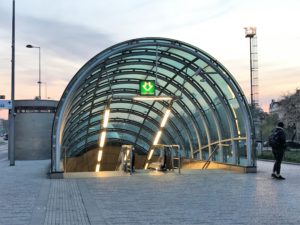
Look for ghosts and ruins
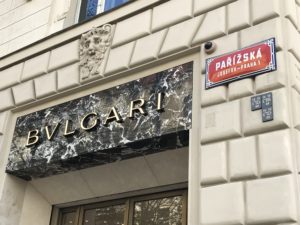
Most Prague guidebooks mention the Old Jewish Quarter. Looking on Google Maps I figured I had walked through the Old Jewish Quarter many times without noticing. What had me confused is Jerusalem Synagogue near Prague train station is the only place I had noticed on previous trips and that turns out not to be in Josefov.
What I had noticed on previous trips to Prague are streets with high end stores like Bulgari, Fendi and Prada. Turns out the centuries old Jewish Quarter was mostly torn down and rebuilt in the 1890s in Art Nouveau style architecture.
I will be back in Prague this summer and make an effort to travel to the next block and see more of the city blocks still retaining the Old Jewish Cemetery and several synagogues.
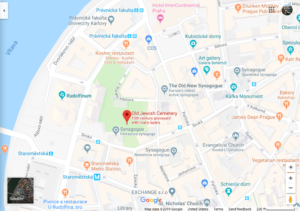
Get there the hard way
Google Maps is a great resource when I need transportation in Prague. I was amazed how accurate Google Maps was for to the minute transportation options around Prague. However, I don’t tend to study Google Maps as I walk around. My preference is simply to look around and walk streets that appeal to me when heading in a general direction to a particular place.
Kelley was angry with me one evening in Prague when she wanted me to take her to a specific restaurant and I refused to use Google Maps, instead relying on my prior knowledge of the area. That was a fail as I walked down streets and brought us back to the same church from three different directions. Not risking further marital frustration with my confusion, I decided to simply go to the restaurant we were standing in front of and that turned out to make our list as one of our favorite places in Prague to eat and drink.
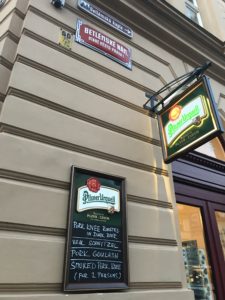
Ironically, after dinner and 3 pints at another nearby pub, I assured Kelley that I now knew exactly how to get to the restaurant I was unable to find earlier. I took us directly to U Dvou Kocek. Unfortunately, we arrived ten minutes before they closed and it was too late for a beer. Perhaps that was fortunate since we already had plenty for the night. Two days later we dined at U Dvou Kocek with fresh locational sense.
Many of the places I have found in Prague over the past few years were due to aimlessly wandering in a general direction, often in an attempt to return to a place I had previously been, only to get lost and find something new to add to my list of places to try and return to on another trip in Prague.
Eat somewhere dubious
I arrived in Prague from Copenhagen about 8 hours before my wife who flew from Paris to Prague. Google Maps showed the quickest route to Clarion Prague Old Town was via a tram rather than the Metro. I enjoyed traveling to the city overground for the first time after more than a dozen Metro trips between Prague Airport and the city over the past few years.
The week before going to Prague I had developed the idea of exploring neighborhoods around Prague 6 in a part of the city unfamiliar to me. As the tram meandered downhill to the city I noticed a restaurant from the tram that attracted my attention for no discernible reason.
When we think about food writers and restaurant critics, we think of their haute cuisine experience and their evaluations of fancy restaurants. But the best of this lot also have an appetite for oddball out-of-the-way places in obscure neighbourhoods.
Kelley and I had visited Prague Castle approaching from Charles Bridge and Mala Strana. After walking around the castle I led us out the other side into Prague 6 heading toward Hradcanska Metro, but got sidetracked. We entered a crowded restaurant with upscale prices and waited for someone to approach us, but after a couple of minutes with staff not giving us any acknowledgement, we walked out. As we headed toward the busier street I realized the restaurant I had seen from the tram three days before was across the street.

Turned out to be the first restaurant in Prague we had visited without an English language menu. We watched local football teams on the TV with other patrons and drank cheap 36 CZK/$1.57 pints of Kozel in what turned out to be one of the best times we had all week dining in a place with no other tourists.
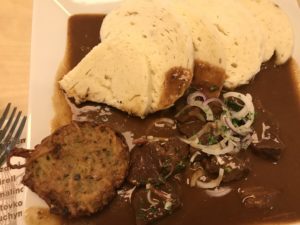
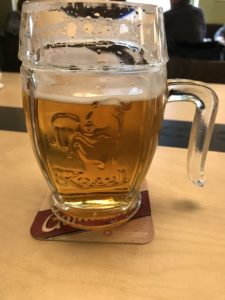
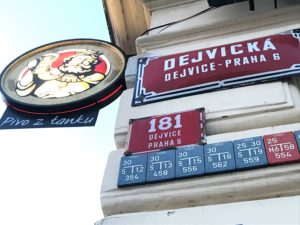
Read the plaque
Another interesting aspect of dining at Betlémská kaple restaurace on our last night in Prague was noticing a plaque on the church on the square for which the restaurant is named. Spend time in Prague or reading city history and the name Jan Hus will probably come to your attention. He was a scholar and church reformer a century before Martin Luther. In 1415 Jan Hus was convicted of heresy in Constance and burned at the stake. His followers, Hussites, transformed the church in Bohemia and led to a series of Crusades launched against the Hussites for two decades. These were the Hussite Wars.
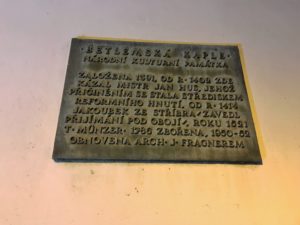
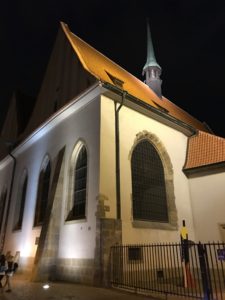
Roman Mars, creator of the popular podcast series 99% Invisible, has made “read the plaque†a recurring mantra. As he repeatedly points out, plaques often tell fascinating stories hidden in plain sight.
The day after we left Prague, while sitting in my hotel room in Oslo, Norway looking at my photo of the plaque had me wondering about the connection between Betlémská kaple and Jan Hus. Turns out Betlémská kaple/Bethlehem Chapel was where Jan Hus was the rector and preached.

Follow the quiet
On my walks around Prague I have found myself often walking into courtyards from noisy streets to find a tranquil space. The Vltava River has major road traffic along many parts of the city riverfront. With a desire to get away from the noise I walked into a courtyard to find a quiet space where the only people I saw were two women relaxing on benches soaking up the sun. The walls surrounding the buildings and open space blocked out much of the city noise.
In the PBS Digital Studios series The Art Assignment, Jace Clayton (also known as DJ /rupture) offered a simple set of instructions.
Go for a walk outside, he advised, but make it a point to head out in the direction that seems the most quiet. Keep going until you find the quietest spot in your vicinity that you can. Now stop and be in that place. ‘Take a moment to absorb it,†as his instructions put it.
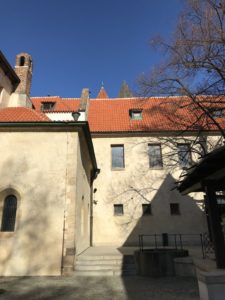
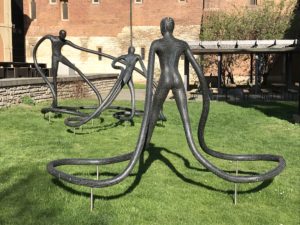
All text in quote offsets are from Rob Walker’s article The art of noticing: five ways to experience a city differently – The Guardian (May 9, 2019).



7 Comments
Comments are closed.